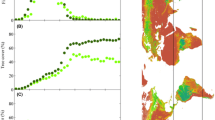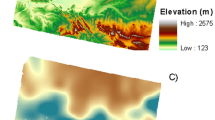Abstract
Fire is an important natural disturbance process in arid grasslands but current fire regimes are largely the result of both human and natural processes and their interactions. The collapse of the Soviet Union in 1991 spurred substantial socioeconomic changes and was ultimately followed by a rapid increase in burned area in southern Russia. What is unclear is whether this increase in burned area was caused by decreasing livestock numbers, vegetation changes, climate change, or interactions of these factors. Our research goal was to identify the driving forces behind the increase in burned area in the arid grasslands of southern Russia. Our study area encompassed 19,000 km2 in the Republic of Kalmykia in southern Russia. We analyzed annual burned area from 1986 to 2006 as a function of livestock population, NDVI, precipitation, temperature, and broad-scale oscillation indices using best subset regressions and structural equation modeling. Our results supported the hypothesis that vegetation recovered within 5–6 years after the livestock declined in the beginning of the 1990s, to a point at which large fires could be sustained. Climate was an important explanatory factor for burning, but mainly after 1996 when lower livestock numbers allowed fuels to accumulate. Ultimately, our results highlight the complexity of coupled human-natural systems, and provide an example of how abrupt socioeconomic change may affect fire regimes.






Similar content being viewed by others
References
Archer S, Schimel DS, Holland EA. 1995. Mechanisms of shrubland expansion—land-use, climate or CO2. Clim Change 29:91–9.
Archibald S, Bond WJ. 2004. Grazer movements: spatial and temporal responses to burning in a tall-grass African savanna. Int J Wildland Fire 13:377–85.
Balzter H, Gerard FF, George CT, Rowland CS, Jupp TE, McCallum I, Shvidenko A, Nilsson S, Sukhinin A, Onuchin A, Schmullius C. 2005. Impact of the Arctic Oscillation pattern on interannual forest fire variability in Central Siberia. Geophys Res Lett 32.
Bananova VA. 1992. Antropogenic desertification of arid grasslands of Kalmykia. Doctoral Thesis. Institute of deserts, Ashkhabad (in Russian).
Barnston AG, Livezey RE. 1987. Classification, seasonality and persistence of low-frequency atmospheric circulation patterns. Mon Weather Rev 115:1083–126.
Beckage B, Platt WJ, Slocum MG, Pank B. 2003. Influence of the El Nino Southern Oscillation on fire regimes in the Florida everglades. Ecology 84:3124–30.
Bollen KA. 1989. Structural equations with latent variables. New York: Wiley.
Bond WJ, van Wilgen BW. 1996. Fire and plants. London: Chapman and Hall.
Box EO, Holben BN, Kalb V. 1989. Accuracy of the AVHRR vegetation Index as a predictor of biomass, primary productivity and net CO2 flux. Vegetatio 80:71–89.
Brooks ML, D’Antonio CM, Richardson DM, Grace JB, Keeley JE, DiTomaso JM, Hobbs RJ, Pellant M, Pyke D. 2004. Effects of invasive alien plants on fire regimes. Bioscience 54:677–88.
Buermann W, Anderson B, Tucker CJ, Dickinson RE, Lucht W, Potter CS, Myneni RB. 2003. Interannual covariability in Northern Hemisphere air temperatures and greenness associated with El Nino-Southern Oscillation and the Arctic Oscillation. J Geophys Res Atmos 108.
Chow GC. 1960. Tests of equality between sets of coefficients in two linear regressions. Econometrica 28:591–605.
Chuvieco E, Englefield P, Trishchenko AP, Luo Y. 2008. Generation of long time series of burn area maps of the boreal forest from NOAA-AVHRR composite data. Remote Sens Environ 112:2381–96.
CIESIN, CIAT. 2005. Gridded Population of the World Version 3 (GPWv3): Population Density Grids. Socioeconomic Data and Applications Center (SEDAC), Columbia University, Palisades, NY. http://sedac.ciesin.columbia.edu/gpw. Accessed: 06.28.2009.
Csiszar I, Denis L, Giglio L, Justice CO, Hewson J. 2005. Global fire activity from two years of MODIS data. Int J Wildland Fire 14:117–30.
D’Antonio CM, Vitousek PM. 1992. Biological invasions by exotic grasses, the grass fire cycle, and global change. Annu Rev Ecol Syst 23:63–87.
Diamond J. 2001. Ecology: dammed experiments!. Science 294:1847–8.
Dubinin M, Potapov P, Lushchekina A, Radeloff VC. 2010. Reconstructing long time series of burned areas in arid grasslands of southern Russia by satellite remote sensing. Remote Sens Environ 114:1638–48.
Dzhapova RR. 2007. Dynamics of vegetative cover of Ergeni highlands and Caspian lowlads within Republic of Kalmykia. Moscow: Moscow State University (in Russian).
Fensholt R, Rasmussen K, Nielsen TT, Mbow C. 2009. Evaluation of earth observation based long term vegetation trends—intercomparing NDVI time series trend analysis consistency of Sahel from AVHRR GIMMS, Terra MODIS and SPOT VGT data. Remote Sens Environ 113:1886–98.
Flannigan MD, Wotton BM. 2001. Climate, weather, and area burned. In: Johnson EA, Miyanishi K, Eds. Forest fires. San Diego: Academic Press.
Golub VB. 1994. The desert vegetation communities of the Lower Volga Valley. Feddes Repert 105:499–515.
Grace J. 2006. Structural equation modeling and natural systems. Cambridge: Cambridge University Press.
Grace JB, Bollen KA. 2006. The interface between theory and data in structural equation models. Open-File Report 2006–1363. Reston (VA): U.S. Geological Survey.
Greenville AC, Dickman CR, Wardle GM, Letnic M. 2009. The fire history of an arid grassland: the influence of antecedent rainfall and ENSO. J Wildl Fire 18:631–9.
Guevara JC, Stasi CR, Wuilloud CF, Estevez OR. 1999. Effects of fire on rangeland vegetation in south-western Mendoza plains (Argentina): composition, frequency, biomass, productivity and carrying capacity. J Arid Environ 41:27–35.
Holmgren M, Stapp P, Dickman CR, Gracia C, Graham S, Gutierrez JR, Hice C, Jaksic F, Kelt DA, Letnic M, Lima M, Lopez BC, Meserve PL, Milstead WB, Polis GA, Previtali MA, Michael R, Sabate S, Squeo FA. 2006. Extreme climatic events shape arid and semiarid ecosystems. Front Ecol Environ 4:87–95.
Hurrell JW, Kushnir Y, Ottersen G, Visbeck M. 2003. An overview of the North Atlantic oscillation. In: Hurrell JW, Kushnir Y, Ottersen G, Visbeck M, Eds. The North Atlantic oscillation: climate significance and environmental impact. Washington, DC: American Geophysical Union.
Jöreskog KG, Sörbom D. 1984. LISREL VI User’s guide. Uppsala: Department of Statistics, University of Uppsala.
Kalmstat. 2008. Livestock census of 2008. Elista: ROSSTAT.
Keeley JE. 2004. Impact of antecedent climate on fire regimes in coastal California. Int J Wildland Fire 13:173–82.
Knapp PA. 1998. Spatio-temporal patterns of large grassland fires in the Intermountain West, USA. Glob Ecol Biogeogr 7:259–72.
Krichak SO, Kishcha P, Alpert P. 2002. Decadal trends of main Eurasian oscillations and the Eastern Mediterranean precipitation. Theor Appl Climatol 72:209–20.
Kroonenberg SB, Rusakov GV, Svitoch AA. 1997. The wandering of the Volga delta: a response to rapid Caspian sea-level change. Sed Geol 107:189–209.
Kurinova ZS, Belousova ZN. 1989. Effective use of forage resources. Elista: Kalmyk book publishing.
Le Page Y, Pereira JMC, Trigo R, da Camara C, Oom D, Mota B. 2008. Global fire activity patterns (1996–2006) and climatic influence: an analysis using the World Fire Atlas. Atmos Chem Phys 8:1911–24.
Letnic M. 2004. Cattle grazing in a hummock grassland regenerating after fire: the short-term effects of cattle exclusion on vegetation in south-western Queensland. Rangel J 26:34–48.
Meyn A, White PS, Buhk C, Jentsch A. 2007. Environmental drivers of large, infrequent wildfires: the emerging conceptual model. Prog Phys Geogr 31:287–312.
Mitchell TD, Jones PD. 2005. An improved method of constructing a database of monthly climate observations and associated high-resolution grids. Int J Climatol 25:693–712.
Mouillot F, Field CB. 2005. Fire history and the global carbon budget: a 1 degrees × 1 degrees fire history reconstruction for the 20th century. Glob Change Biol 11:398–420.
Neronov VV. 1998. Anthropogenic grasslands encroachment of desert pastures of North-Western Precaspian plains. Successes Modern Biol 118:597–612 (in Russian).
New M, Hulme M, Jones P. 1999. Representing twentieth-century space-time climate variability. Part I: Development of a 1961–90 mean monthly terrestrial climatology. J Clim 12:829–56.
Pallas PS, Blagdon FW. 1802. Travels through the southern provinces of the Russian Empire, in the years 1793 and 1794. London: A. Strahan for T.N. Longman and O. Rees.
Paruelo JM, Epstein HE, Lauenroth WK, Burke IC. 1997. ANPP estimates from NDVI for the Central Grassland Region of the United States. Ecology 78:953–8.
Pausas JG. 2004. Changes in fire and climate in the eastern Iberian Peninsula (Mediterranean basin). Clim Change 63:337–50.
Pyne SJ. 1984. Introduction to wildland fire. New York: Wiley.
R Development Core Team. 2009. R: A language and environment for statistical computing. R Foundation for Statistical Computing. Vienna, Austria. http://www.R-project.org.
Saiko T, Zonn I. 1997. Europe’s first desert. In: Glantz M, Zonn I, Eds. Scientific, environmental and political issues in the circum-Caspian region. Dordrecht, Boston, London: Kluwer Academic Publishers. p 141–4.
Savage M, Swetnam TW. 1990. Early 19th-century fire decline following sheep pasturing in a Navajo ponderosa pine forest. Ecology 71:2374–8.
Schonher T, Nicholson SE. 1989. The relationship between California rainfall and ENSO events. J Clim 2:1258–69.
Sinclair ARE, Fryxell JM. 1985. The Sahel of Africa—ecology of a disaster. Can J Zool 63:987–94.
Stohl A, Berg T, Burkhart JF, Fjaeraa AM, Forster C, Herber A, Hov O, Lunder C, McMillan WW, Oltmans S, Shiobara M, Simpson D, Solberg S, Stebel K, Strom J, Torseth K, Treffeisen R, Virkkunen K, Yttri KE. 2007. Arctic smoke—record high air pollution levels in the European Arctic due to agricultural fires in Eastern Europe in spring 2006. Atmos Chem Phys 7:511–34.
Tansey K, Gregoire JM, Stroppiana D, Sousa A, Silva J, Pereira JMC, Boschetti L, Maggi M, Brivio PA, Fraser R, Flasse S, Ershov D, Binaghi E, Graetz D, Peduzzi P. 2004. Vegetation burning in the year 2000: Global burned area estimates from SPOT VEGETATION data. J Geophys Res Atmos 109.
Tucker CJ, Vanpraet CL, Sharman MJ, Vanittersum G. 1985. Satellite remote-sensing of total herbaceous biomass production in the Senegalese Sahel—1980–1984. Remote Sens Environ 17:233–49.
Tucker CJ, Pinzon JE, Brown ME, Slayback DA, Pak EW, Mahoney R, Vermote EF, El Saleous N. 2005. An extended AVHRR 8-km NDVI dataset compatible with MODIS and SPOT vegetation NDVI data. Int J Remote Sens 26:4485–98.
Turner MG, Gardner RH. 1991. Quantitative methods in landscape ecology: an introduction. In: Turner MG, Gardner RH, Eds. Quantitative methods in landscape ecology. New York: Springer.
van de Koppel J, Rietkerk M, Weissing FJ. 1997. Catastrophic vegetation shifts and soil degradation in terrestrial grazing systems. Trends Ecol Evol 12:352–6.
van der Werf GR, Randerson JT, Giglio L, Collatz GJ, Kasibhatla PS, Arellano AF. 2006. Interannual variability in global biomass burning emissions from 1997 to 2004. Atmos Chem Phys 6:3423–41.
Vinogradov BV. 1995. Forecasting dynamics of deflated sands of Black Lands, Kalmykia using aerial photography. In: Zonn IS, Neronov VM, Ed. Biota and Environment of Kalmykia, Moscow, Elista (in Russian). pp 259–268.
Walter H, Box E. 1983. Overview of Eurasian continental deserts and semideserts. Ecosystems of the World. Amsterdam: Elsevier. pp 3–269.
Zonn IS. 1995a. Desertification in Russia: problems and solutions (an example in the Republic of Kalmykia-Khalmg Tangch). Environ Monit Assess 37:347–63.
Zonn SV. 1995b. Desertification of nature resources in Kalmykia during last 70 years and protection measures. Moscow, Elista: Biota and Environment of Kalmykia. pp 12–52 (in Russian).
Acknowledgments
We gratefully acknowledge support for this research by the NASA Land-Cover and Land-Use Change Program, a NASA Earth System Science Dissertation Fellowship for M. Dubinin (07-Earth07F-0053), and the National Geographic Society. We are thankful for J. Burton’s help with structural equation modeling and N. Keuler’s assistance with statistics.
Author information
Authors and Affiliations
Corresponding author
Additional information
Author Contributions
MD designed study, performed research, analyzed data, wrote the paper; AL designed study, contributed new methods, performed research; VR performed research, wrote the paper.
Rights and permissions
About this article
Cite this article
Dubinin, M., Luschekina, A. & Radeloff, V.C. Climate, Livestock, and Vegetation: What Drives Fire Increase in the Arid Ecosystems of Southern Russia?. Ecosystems 14, 547–562 (2011). https://doi.org/10.1007/s10021-011-9427-9
Received:
Accepted:
Published:
Issue Date:
DOI: https://doi.org/10.1007/s10021-011-9427-9




